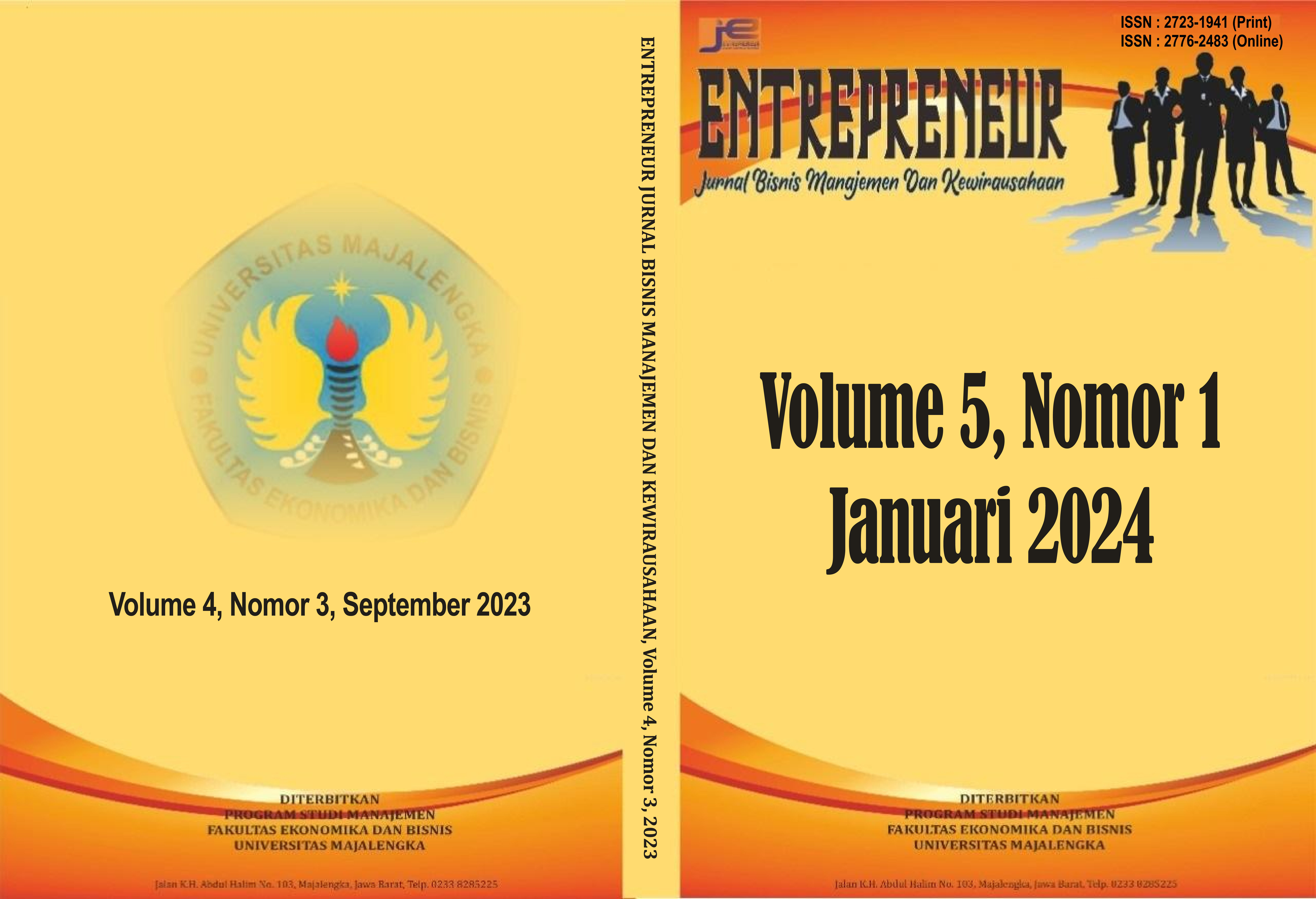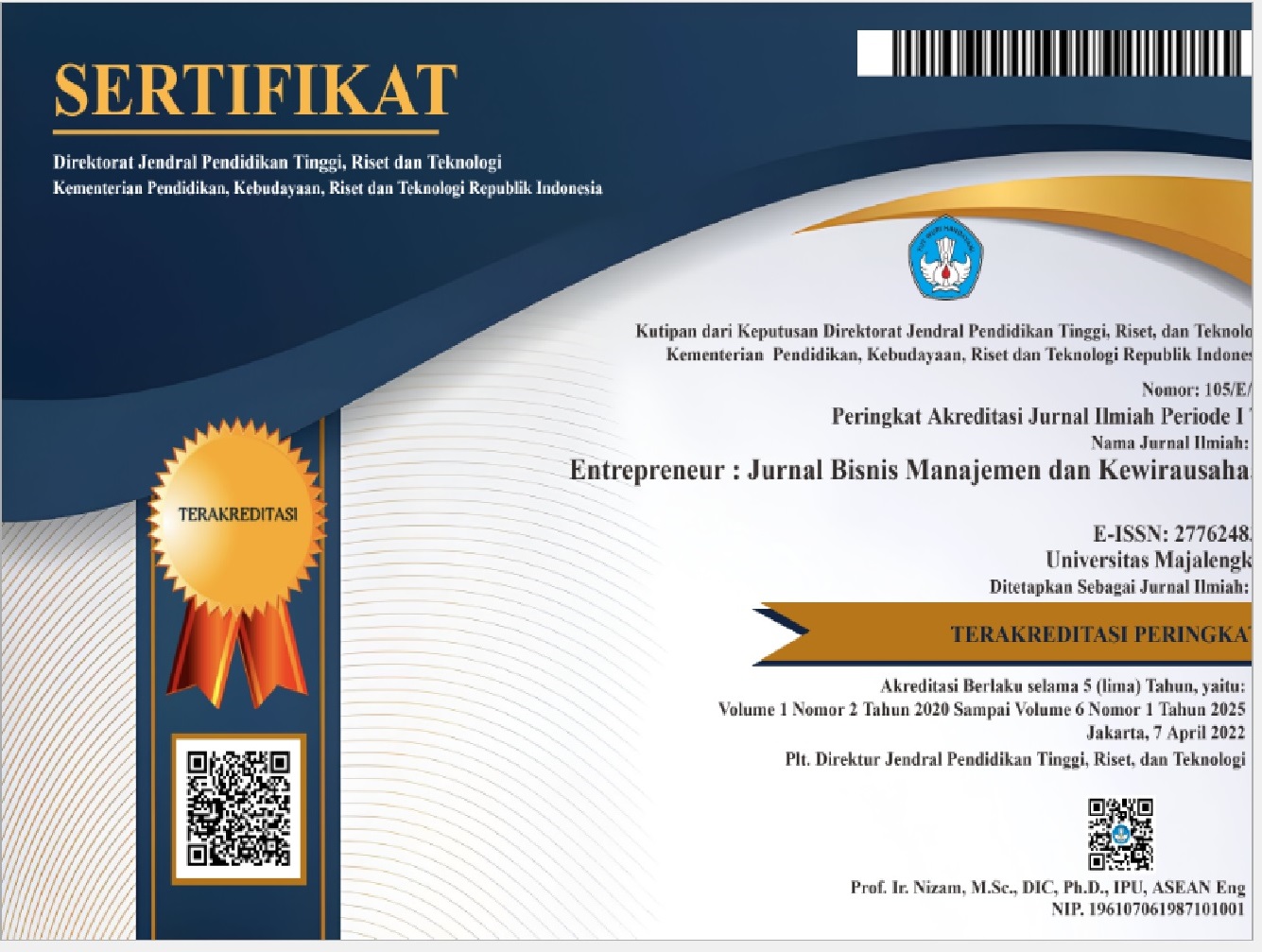The Competence in the Digital Era in Improving Public Service Performance
DOI:
https://doi.org/10.31949/entrepreneur.v5i1.7670Abstrak
This study will explain the competence of human resources in the digital era to influence better performance. The human resources needed by the industry today are those who have competence in using digital technology. This competency is to realize intelligent factories, such as the Internet of Things (IoT). The era of the industrial revolution 4.0 opens opportunities for human resources (HR) to have skills following the latest technological developments. For this reason, civil servants who are state apparatus must be able to answer the challenges and master competencies in the digitalization era, including complex problem solving, critical thinking, creativity, human resource management, coordination with others, emotional intelligence, judgment and decision making, orientation service, Negotiation, and cognitive flexibility. This study uses quantitative research methods through the distribution of questionnaires or questionnaires to respondents who have been determined using sampling. The analytical technique used is structural equation modeling analysis. The results show that the appropriate competencies in the digitalization have a significant influence on the performance of public services.
Kata Kunci:
Organization, Competence, PerformanceUnduhan
Referensi
Alonso, P., & Lewis, G. (2001). Public Service Motivation and Job Performance. The American Review of Public Administration, 31, 363–380. https://doi.org/10.1177/02750740122064992
Ardiani, Nunuk, G. (1996). Organisasi (Perilaku, Struktur, Proses). Binarupa Aksara.
Blanka, C., Krumay, B., & Rückel, D. (2022). The interplay of digital transformation and employee competency: A design science approach. Technological Forecasting and Social Change, 178, 121575. https://doi.org/10.1016/j.techfore.2022.121575
Gielen, A. C., Kerkhofs, M. J. M., & van Ours, J. C. (2009). How performance related pay affects productivity and employment. Journal of Population Economics, 23(1), 291–301. https://doi.org/10.1007/s00148-009-0252-9
Haq, S. (2011). Ethics and leadership skills in the public service. Procedia - Social and Behavioral Sciences, 15, 2792–2796. https://doi.org/10.1016/j.sbspro.2011.04.190
Hariandja, M. T. E. (2002). Manajemen Sumber Daya Manusia. Grasindo.
Hsiao, C.-T., & Lin, J.-S. (2008). A Study of Service Quality in Public Sector. International Journal of Electronic Business Management, 6(1), 29–37.
Jonathan, L. R., Titin Ruliana, & Siswanto, E. (2017). Quality of Public Services. Research Journal of Accounting and Business Management, 1(1), 14–28.
Kazlauskaite, R., & Buciuniene, I. (2008). The Role of Human Resources and Their Management in the Establishment of Sustainable Competitive Advantage. Engineering Economics, 5, 78–85.
Keban, Y. T. (2008). Enam Dimensi Strategis Administrasi Publik : Konsep, Teori, Dan. Isu. Gava Media.
Kusumawardani. (2011). Penilaian Aset Sumber Daya Manusia. Media Trend, 6(1), 138–155.
Leni Rohid. (2018). Pengaruh Era Revolusi Industri 4.0 terhadap Kompetensi Sumber Daya Manusia. Jurnal Manajemen Bisnis Indonesia, 6(1), 114–136. http://www.ou.edu/mideast/Additional pages - non-catagory/Zisser_al-Asad_and_his_Regime_2004.htm
Maslennikov, V. V., Kalinina, I. A., Ekimova, K. V., Kornilova, I. M., & Samokhina, E. A. (2017). Survey of public awareness of services provided by employment centers. European Research Studies Journal, 20(2), 411–428.
Mathis Robert, J. J. (2002). Manajemen Sumber Daya Manusia. Salemba Empat.
Mislan Sihite. (2018). Peran Kompetensi dalam Mewujudkan Sumber Daya Manusia yang Berdaya Saing Tinggi di Era Revolusi Industri 4.0: Suatu Tinjauan Konseptual. Biomass Chem Eng, 3(2), ثقثقثقثق. http://journal.stainkudus.ac.id/index.php/equilibrium/article/view/1268/1127%0Ahttp://publicacoes.cardiol.br/portal/ijcs/portugues/2018/v3103/pdf/3103009.pdf%0Ahttp://www.scielo.org.co/scielo.php?script=sci_arttext&pid=S0121-75772018000200067&lng=en&tlng=
Mwaniki, R., & Gathenya, J. (2015). Role of Human Resource Management Functions On Organizational Performance with reference to Kenya Power & Lighting Company â Nairobi West Region. International Journal of Academic Research in Business and Social Sciences, 5(4), 432–448. https://doi.org/10.6007/ijarbss/v5-i4/1584
Naher, N., Hoque, R., Hassan, M. S., Balabanova, D., Adams, A. M., & Ahmed, S. M. (2020). Erratum: Correction to: The influence of corruption and governance in the delivery of frontline health care services in the public sector: a scoping review of current and future prospects in low and middle-income countries of south and south-east Asia (BM. BMC Public Health, 20(1), 1082. https://doi.org/10.1186/s12889-020-09197-0
Najeeb, A. (2013). The role of HR actors in designing and implementing HRM in tourist resorts in the Maldives. Employee Relations, 35. https://doi.org/10.1108/ER-08-2012-0057
Palan, R. (2007). Competency Management: Teknis Mengimplementasikan. Manajemen SDM Berbasis Kompetensi untuk Meningkatkan Daya Saing Organisasi. PPM.
Pham Thanh Huu. (2022). Impact of Employee Digital Competence on the Relationship between Digital Autonomy and Innovative Work Behavior : A Systematic Review. Research Square.
Putra, D. (2019). Administration in Department Population and Civil Registration of Sungai Penuh. International Journal of Progressive Sciences and Technologies (IJPSAT), 14(2), 267–272. https://doi.org/10.52155
Qutni, D., Kristiawan, M., & Fitriani, Y. (2021). Human Resource Management in Improving The Quality of Education. Edunesia : Jurnal Ilmiah Pendidikan, 2(2), 354–366. https://doi.org/10.51276/edu.v2i2.132
Ritz, A., Vandenabeele, W., & Vogel, D. (2021). Public Service Motivation and Individual Job Performance (pp. 254–277). https://doi.org/10.1093/oso/9780192893420.003.0014
Sanjaya, S., & Yuliastanty, S. (2017). Pengaruh People, Process, dan Physical Evidence terhadap Kepuasan atas Pelayanan Pada Rumah Sakit Siti Rahmah Kota Padang. UNES Journal of Social And Economics Research, 2, 58. https://doi.org/10.31933/ujser.2.1.058-064.2017
Schwarz, G., Eva, N., & Newman, A. (2020). Can Public Leadership Increase Public Service Motivation and Job Performance? Public Administration Review, 80(4), 543–554. https://doi.org/10.1111/puar.13182
Sinambela, L. P. (2010). Reformasi Pelayanan Publik. Bumi Aksara.
Surya Dharma. (2012). Manajemen Kinerja ; Falsafah Teori Dan Penerapannya. Pustaka Pelajar.
Tien, N. (2021). Current situation of high quality human resources in FDI enterprises in Vietnam-solutions to attract and maintain.
Tjiptono, F. dan G. C. (2011). Service, Quality and Satisfaction, ed. 3. Andi Offset.
Van de Walle, S. (2003). Public Service Performance and Trust in Government: The Problem of Causality. International Journal of Public Administration, 26. https://doi.org/10.1081/PAD-120019352
Whitmore, J. (1997). Coaching Performance. Gramedia Pustaka Utama.
Yani, A. A., & Ahmad, S. (2017). Public Service Performance and Public Trust in Government. 43(Icas), 86–89.
Yusriadi, Y. (2018). Bureaucratic Reform to the improvement of public services Challenges for Indonesia. Publikauma: Jurnal Administrasi Publik Universitas Medan Area, 6, 15–29.

Diterbitkan
Cara Mengutip
Terbitan
Bagian
Lisensi
Hak Cipta (c) 2024 Hafni Rizanuddin Nur

Artikel ini berlisensiCreative Commons Attribution-ShareAlike 4.0 International License.
COPYRIGHT NOTICE
An author who publishes in the Entrepreneur: Jurnal Bisnis Manajemen dan Kewirausahaan agrees to the following terms:
1. Author retains the copyright and grants the journal the right of first publication of the work simultaneously licensed under the Creative Commons Attribution-ShareAlike 4.0 License that allows others to share the work with an acknowledgment of the work's authorship and initial publication in this journal
2. The author is able to enter into separate, additional contractual arrangements for the non-exclusive distribution of the journal's published version of the work (e.g., post it to an institutional repository or publish it in a book) with the acknowledgment of its initial publication in this journal.
3. The author is permitted and encouraged to post his/her work online (e.g., in institutional repositories or on their website) prior to and during the submission process, as it can lead to productive exchanges, as well as earlier and greater citation of the published work







